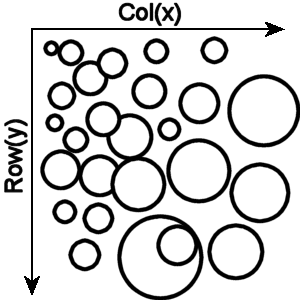
Diagrams to be generated
This page is no longer being updated as it has been relocated to http://www.mcs.vuw.ac.nz/~elvis/db/FishBrainWiki?Diagrams.
Three broad categories
Spatial (dependencies)
Distribution of data Clump location and size. Try using clump as unit of visualisation. Clump map How people use depth within a spreadsheet. Cell width and height used for layout. Merged cells, cell width and height.
In-between spatial and logical
Location of formula (like sum) on spreadsheet.
Suspect sum will be bottom left.
How tall are the dependency trees within each sheet, how bushy, wide
How many cells refer to 1 (many) 2 (many) 3 (lots) Dozens or hundreds via ranges (hundreds).
Distance of Vectors.
 Average Formula size
Average Formula size
Number of cells referenced (Number of cells in range)
Number of Functions used.
 I had an idea to focus on the family tree of just one cell. Is there a strong overlap (in breeding area) between the two trees?
I had an idea to focus on the family tree of just one cell. Is there a strong overlap (in breeding area) between the two trees?
Logical (articulation)
Use of simple formulas verses complex formulas.
Cell types (int,date,formula,string)
Number of cells refered to from each formula.
Larger formulas will be more complicated, harder to understand and debug. Often reference more cells. Larger number of brackets.
Fan in/ Fan out
Comparing different formulas could be done via number of steps needed to edit one into the other. (Ray Moony).
Location of formula.
Simple formulas - single functions.
Cell types
Measures of complexity of formulas.
Compass view (ridial spiderweb graph) General direction of dependency flow. Which way do most outbound referneces go, in bould.
Histograms of number of cells in a worksheet. Then breakit down into what level these cells are in.
Cells referenced vs Formula length
Temporial
Could be useful for documenting the evolution of spreadsheets. Excel version number, Saved date.
Other
Ownership trees - if one cell refers to another (and is the only cell to refer to that cell) it owns this cell.
Power laws (Smallworld from psychology) (Zipf law) - Many refer to the few and few refer to the many. Small hops - Giant hop - Small hops.
- Real estate for a single spreadsheet - at individual cell level and entire sheet dimensions.
- Average Cell unit vectors - Direction of dependency flow
- Formula Complexity using string length
- Tree tracing from root cells
- Spatial Clustering of cells
- Tracing of Family Trees for all root cells
- Compass view of dependency direction
- Do finiancial spreadsheets use the financial functions provided by Excel?
- Total number of Cells referenced vs the # of referenceing elements (Single cell, range, union, etc...)
- A Bargraph showing the breakdown of formula elements into categories (operators, funcitons, references, values(String, numbers, dates)).